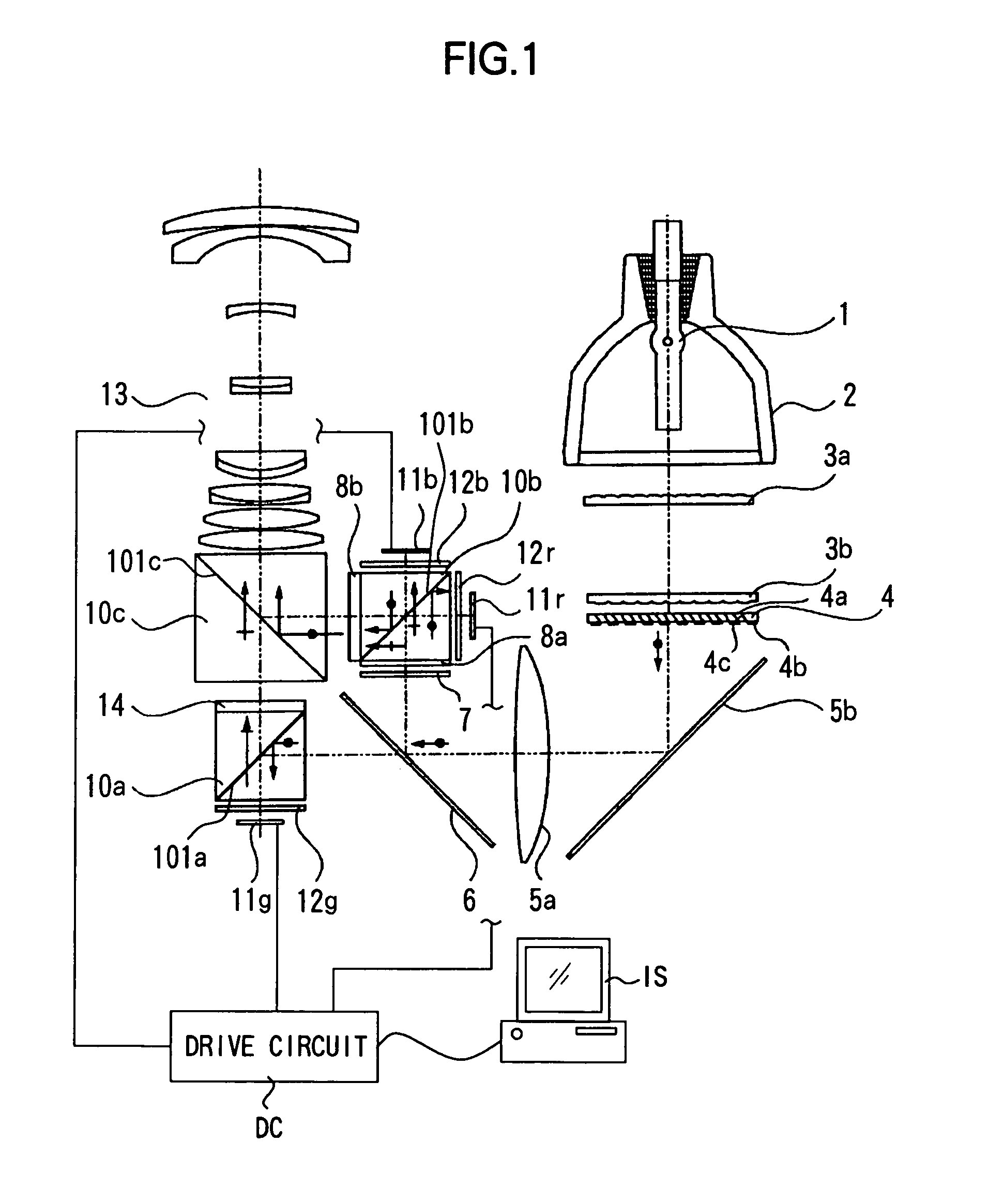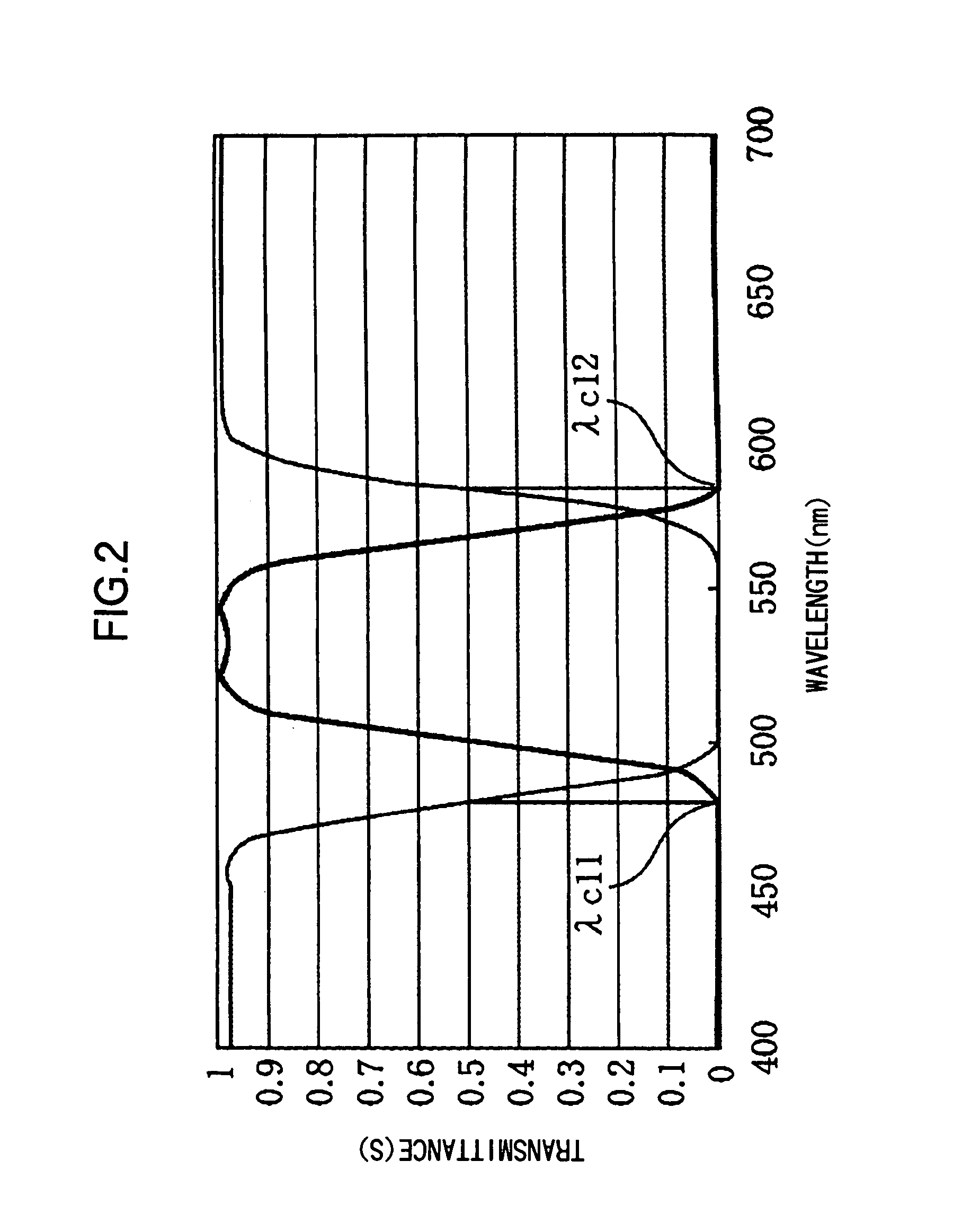Color splitting/combining optical system and image projecting apparatus
- Summary
- Abstract
- Description
- Claims
- Application Information
AI Technical Summary
Benefits of technology
Problems solved by technology
Method used
Image
Examples
embodiment 1
(Embodiment 1)
[0072]FIG. 1 is a view representing Embodiment 1 according to the present invention. In the drawing, Reference Numeral 1 denotes a light source which emits white-color light with a continuous spectrum. Reference Numeral 2 denotes a reflector which condenses light in a predetermined direction. Reference Numeral 3a denotes a first fly-eye lens having rectangular lenses disposed in a matrix state, and 3b denotes a second fly-eye lens constituted by lens arrays corresponding to respective lenses of the first fly-eye lens.
[0073]Reference Numeral 4 denotes a polarization converting element which makes non-polarized light into predetermined polarized light. Reference Numeral 5a denotes a condenser lens and 5b denotes a mirror. Reference Numeral 6 denotes a dichroic mirror which is a first optical member, which reflects light components of wavelength regions of blue (B) and red (R) and transmits a light component of a wavelength region of green (G).
[0074]Reference Numeral 7 de...
embodiment 2
(Embodiment 2)
[0093]FIG. 4 is a view representing Embodiment 2 according to the present invention, wherein parts which are identical to those in Embodiment 1 are given the same Reference Numerals. A point in which Embodiment 2 differs from Embodiment 1 resides in that the arrangement of the reflection type liquid crystal display element for R and the reflection type liquid crystal display element for B is reversed. Therefore, in Embodiment 2, the first color-selective wave plate 28a which converts the polarization direction of the light component of R by 90 degrees but does not convert the polarization direction of the light component of B, and the second color-selective wave plate 28b which converts the polarization direction of the light component of B by 90 degrees but does not convert the polarization direction of the light component of R are provided.
[0094]FIG. 5 shows the characteristics of the first color-selective wave plate according to the present embodiment with thick lin...
embodiment 3
(Embodiment 3)
[0102]FIG. 6 is a view representing Embodiment 3 according to the present invention, wherein parts which are identical to those of Embodiment 1 are given the same Reference Numerals. A point in which Embodiment 3 differs from Embodiment 1 resides in that Embodiment 3 is provided with a polarization converting element 34 by which non-polarized light is aligned to be P-polarized light. Therefore, a first color-selective wave plate 38a which converts the polarization direction of the light component of R by 90 degrees but does not convert the polarization direction of the light component of B, and a second color-selective wave plate 38b which rotates the polarization direction of the light component of R by 90 degrees but does not convert the polarization direction of the light component of B are provided therein, and the ½ wave plate 31 which converts the polarization direction of light G by 90 degrees is provided at the incidence side of the first polarization beam spli...
PUM
 Login to View More
Login to View More Abstract
Description
Claims
Application Information
 Login to View More
Login to View More - R&D
- Intellectual Property
- Life Sciences
- Materials
- Tech Scout
- Unparalleled Data Quality
- Higher Quality Content
- 60% Fewer Hallucinations
Browse by: Latest US Patents, China's latest patents, Technical Efficacy Thesaurus, Application Domain, Technology Topic, Popular Technical Reports.
© 2025 PatSnap. All rights reserved.Legal|Privacy policy|Modern Slavery Act Transparency Statement|Sitemap|About US| Contact US: help@patsnap.com



